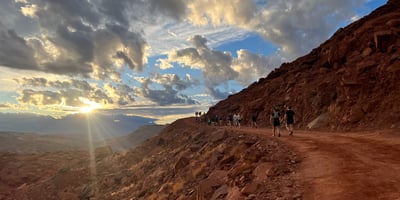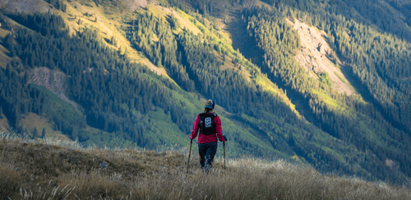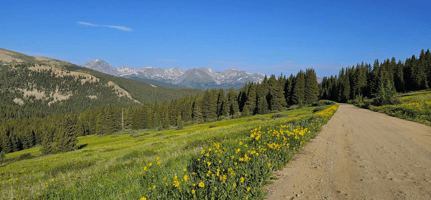News flash: I'm not elite! I don't compete for prize money. I like taking pictures and stopping on...
How to Finish The Ouray 100 - A Collection of Wisdom
The Ouray 100 follows a complex route through the San Juan Mountains in SW Colorado, covering over 100 miles and 40,000' of climbing and descent. With a 52-hour cutoff and a 50% finish rate, success is not guaranteed!
We asked past finishers for wisdom on how to approach this race. Their responses are as follows:
Anne Tisdell:
My top tips to set yourself up for success at Ouray 100:
1. Pace yourself. This is not your average 100-miler, and it will take most runners 40+ hours to get across that finish line. Try to keep your rate of perceived exertion (RPE) in the neighborhood of 4-5/10 throughout the race. If you have moments where your effort creeps higher (a key sign is if you struggle to speak in complete sentences), reassess whether your pace is sustainable for the duration of the race.
2. Save your quads. The steep, slippery downhills can be even harder on your legs than the demanding climbs. Stay relaxed - but focused - and be prepared to use your poles for extra support as you descend to preserve your legs for the long journey ahead.
3. Consider the demands of the course and the altitude when planning your nutrition and hydration. The combination of high altitude and long stretches between aid stations means most runners will need to carry a substantial amount of water and electrolytes between aid stations. For example, it can easily take a runner 3+ hours to travel 8 miles on this course, meaning many athletes would need to carry 1.5-3 liters of water for an 8-mile segment. It's also important to consider how easy it is to eat your solid calories. Foods that are particularly chewy or fiddly can be difficult to eat when climbing up steep terrain with your trekking poles and when you're descending down loose scree or slick mud.
4. Approach the race one climb at a time, one aid station at a time. I encourage a mentality for this race that's very much in line with racing a 200-miler. The scope of the full race is so enormous that it's far more digestible to focus on one climb at a time, one mountain at a time, one aid station at a time.
5. Take the weather and your safety gear seriously. In the years that I've raced Ouray 100, we've experienced hail, pouring rain, lightning storms, freezing temperatures, temperatures in the 90's, blazing sun, snow on the course...you name it. Take the advice from the race website and race directors seriously and always have appropriate gear that will keep you safe in inclement weather, regardless of the forecast. Carry a rain jacket, long-sleeve shirt, gloves, a hat, and extra water and calories in case you have to hunker down in the treeline to wait out a lightning storm. (It's been known to happen!)
Beat Jegerlehner:
Ok, mindset. For me, these are the key points:
Don’t think about the whole thing. (This is standard stuff for 100 milers, but especially for this race since it’s so much harder than most.)
DON’T DO MATH. Extrapolating times is folly, particularly in a race that usually goes day–night–day (and probably night again). You’ll see some speedup the second day.
Be overly optimistic (it will get better, right?). This is important because you’re likely to get shit weather at some point during Ouray.
It’s really standard stuff, just dialed up to 11 for Ouray. I think folks who usually have “problem-free” 100s are at the highest risk here, because Ouray is just less likely to go your way with zero problems.
As for lessons learned (from a mid-pack perspective):
Don’t go out too fast and don’t trash your legs on the downhills—especially at the start. Slower folks do need to keep the Ironton cutoffs in mind, though.
Bring poles. 🙂
Don’t underestimate the time between aid stations, even if the distances look okay. Check previous years’ results.
Be prepared for bad weather. It’s fairly likely. Don’t mess with lightning—those passes are long and exposed. Hypothermia is also a real concern, so at the very least bring a trash bag in addition to that ultralight (often useless) rain jacket. Even better, bring actual rain gear. Standard Colorado stuff: weather moves in fast, big temperature swings, etc.
Expect more nausea than usual. Whether it’s altitude or just how tough the race is, many folks struggle with this (I like ginger beer when other things won’t sit well). Keeping fed is extra important.
The first section, until you head up to Ironton, can be really dusty from traffic, which can cause breathing issues.
I always go out too fast and ALWAYS regret it going up to Fort Peabody. Learn from me.
Sun protection is crucial. High-altitude Colorado sun will burn you to a crisp quickly.
That’s about it—just standard ultra advice, turned up to eleven for Ouray. Good luck out there!
Luke Metzger:
Mindset:
1. Believe you can do it.
2. Trust in your training.
3. For me personally, accept the collateral damage to push myself to the edge and refuse to DNF.
Lessons Learned:
1. Put in the vert work in training.
2. Stay Patient... start slower even if you feel you can go faster.
3. Never stop hydrating and never stop the electrolytes.
4. Eat calories from start to finish. This is paramount for Ouray which just keeps kicking the vert at you.
5. Finally, maintain balance in the biomechanics of the legs... hips, quads, hamstrings, calves... learn to engage different muscles at different times to preserve their function.
Paul Nielsen:
When Ouray first came across my radar in 2021, I wanted to do it. I had done seven 100-mile+ distances since finding running in 2016 at age 55. Not that success in any 100 is assured, but Ouray was the first thing I signed up for that I likely could not complete. And that is exactly why I wanted to do it.
My girlfriend at the time asked if I was going to be a whiney crybaby if I DNF’d. I assured her absolutely not. I said if MY finish line wasn’t THE finish line, I would have found my limits having given it my all.
I remember I couldn’t even voice the word “Ouray” when I was first learning about it. My daughter said, “Would you sign up already so we can make plans?!” So I did, trained hard, got it done, and fell in love with Ouray!
Mindset and advice:
1. I’d say immerse your mind in the beauty of Ouray, the vert, the weather and the energy of each runner out there challenging themselves!2. Train on the course if at all possible. Old Twin Peaks is a good segment if you can only get there once.
3. Don’t let any gear failure happen. Carry all the gear to stay warm and dry.
4. Eat and drink what works for you and never run out of food, water, batteries, socks, lube, etc.
5. Have your caffeine pills easily accessible so you can easily get to them when you’re sleep deprived out of your mind!
6. Be patient with your pace, run within yourself, and always move forward with intention. Be as social as you can, but run your own race, riding your own ebb and flow of energy.
Dena Carr:
Mindset:
First of all, this race is very demanding and hard. The climbs are relentless. The descents are relentless. The biggest thing that helped me was to understand that this was going to be a race that involved more power hiking and less running.
With that, it also helped me to wrap my mind around the fact that I will most likely be out there for 40+ hours give or take. Anyone can adapt this realistic thinking. Once you accept that you’ll be hiking and taking longer than you normally do, then at that point, just sit back and enjoy the adventure! It’s easier to enjoy an amazing adventure despite it being hard when you are realistic about the expectations.
My mind going into this race was expecting it to be faster than a backpacking trip but slower than any other 100 miler. However, any section that isn’t climbing or a steep descent then you need to run! Run any time you can, since most places on this course you can’t.
Another thing that helped was to take each major section and treat it as a shorter race in my mind. Meaning, I only think about the next 4-7 miles in front of me rather than the race as a whole. When you are climbing for so many miles, it can be discouraging to think of all the climbing and miles that are left. Focusing on one section at a time helps to build confidence, patience, and keeps the mind in the moment.Lessons Learned:
The first time I ran Ouray, my throat swelled up and I couldn’t take in many calories. Don’t underestimate how altitude can affect your body. I believe the altitude affected my ability to swallow. Be prepared to feel sick and have difficulty swallowing. In that matter, make sure that you take in calories however you can.
The amount of climbing will leave you exhausted and calorie deficient. You will want to fuel more often than what you may be used to in other races.
All the climbing and descending will mess up your feet. The race is so long so above all, take care of your feet! Allow the aid station volunteers or Todd, the med guy, to tape your feet as needed. Don’t let hot spots linger. I recommend Leuko tape, thick socks, and a pair of shoes that are 1/2 size bigger. Foot care and calories are crucial!
Be prepared for mountain weather. It will get hot, cold, and maybe even hail/rain. I suggest a rain jacket, gloves, and a buff to keep your head warm. You don’t take a chance against mountain weather. It will be unpredictable so be extra prepared, more than you would be for any other 100 miler.
While the tips may already be things one may do in other races, remember that issues become more pronounced in a race like this that involves more time on feet and a lot of climbing.
As for anything you can do to help pre-race: hill repeats!! Find the steepest hill and do as many repeats as you have time for!
Eric Makovsky:
Mindset:
I think the biggest mindset shift for me was basically throwing out my plans when it comes to Ouray. Think of Heath Ledger’s Joker talking to Harvey Dent in the hospital: “Do I really look like a guy with a plan? I’m just a dog chasing cars. I wouldn’t know what to do if I caught one. I just do things.” That’s pretty much how I tackle Ouray now—I just do things. Weather changes? I do things. Struggling with altitude? I do things.I believe that mentality allows me to enjoy the many small moments that happen during an event this long (both distance and time-wise). Plus, Ouray inevitably shows the schemers “how pathetic their attempts to control things really are” (yes, more Joker for you).
Mistakes to Avoid:
Ha! How about signing up for Ouray as my second 100-miler ever? Poor life choice there.
On this course, one big mistake is pushing too hard on the first Ironton loop. It’s often during the hottest part of the first day on the sun-exposed side. It’s better to save energy for the backside—which is shaded—and for the second loop, which usually happens at dusk or in the dark.Another personal mistake is being too aggressive on the downhills. I like to imagine my native name is “Runs with Deer,” but in reality, it’s probably “Falls on Face When Not Paying Attention.” The downhills are unforgiving. Even in the one year I didn’t actually fall, I managed to kick a piece of talus into my knee by being too aggressive, and that turned the rest of my race into a death march.
Todd Nardi:
Arguably the toughest ultra endurance run, the Ouray 100 combines massive elevation gain/loss with environmental challenges.
1. Don’t run out of water. Many runners have ended their race in the first 6-8 hours due to early dehydration. Carry plenty of water; don't run out.
2. Keep your nutrition steady. What did you eat during training, why change race day? If you’re eating and drinking even semi normally you may not need electrolyte tabs….I have seen the extra salt cause some major GI issues.3. Extra socks and layers. It can be hot, cold, wet, dry… all within 8 hours. Being able to change wet socks and layer up is always a positive.
4. Be Careful. Going up, of course, you have to watch your step. However, I have seen more muscle wear and tear and fall injuries while descending, especially if you’re bombing that downhill.
These are just a few points of maybe hundreds. As medical lead for the last 4-5 or more years, I can talk about all the amazing places, people, and things I’ve seen in Ouray. Don’t hesitate to reach out to me or my team with any questions or concerns. Run between the cones and everyone goes home safe.
Summary:
In summary, the contributors to this article repeatedly mention the importance of pacing, handling altitude, conserving your legs during long descents, and dividing the course mentally into manageable sections. They also emphasize the importance of maintaining proper hydration and nutrition, taking care of your feet, and being ready for unpredictable weather with appropriate gear.
If you have any personal Ouray 100 experience or tips you'd like to share, please make a comment below!
|
Did you enjoy reading this article? Subscribe to our Newsletter to get posts like this in your inbox. |
Jen and Ryan Wold are trail and ultrarunning coaches at Single Step Running. They offer in-person support and crewing for the Ouray 100. Click to learn more!





